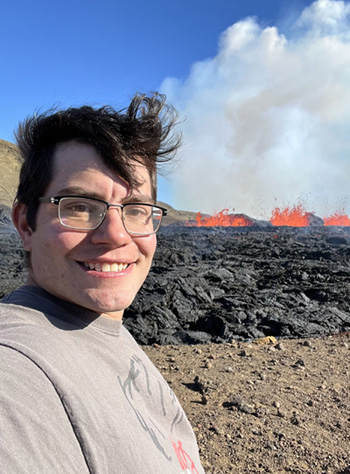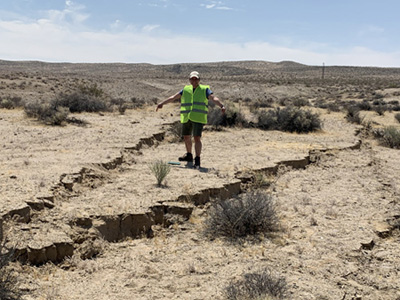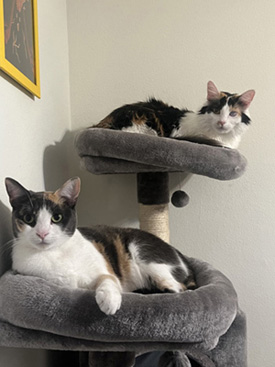4 October 2024–Julian Lozos describes his job—modestly—as “making fake earthquakes on his computer.” But the associate professor of geophysics at California State University, Northridge was also a fan of volcanoes from a young age.
During his last visit at his parents’ home, “my mom found a book that I had made about volcanoes in 1991, and it was questionably correct,” Lozos joked. “When I was five or six, everyone thought I was going to be a field volcanologist, a lava sampler.”

Instead, Lozos turned his attention to music. He sent in his acceptance to graduate school in music composition at University of California, Riverside in 2006, a few days after the 1906 San Francisco earthquake centennial, “which was a big enough deal to be in the news in Pennsylvania, which was where I was living at the time,” he recalled. “That got me reading about the San Andreas Fault, because I thought it was the responsible thing to do”
“I’ve always been interested in the Earth and how it’s a moving, changing dynamic system, even though it’s not alive,” he added. “The more I read, the more I wanted to know and the more questions I had, and meanwhile music grad school was burning me out.”
Then in the summer of 2007 Lozos was in a serious car accident, rolling his car off Highway 101 and “luckily landing in someone’s fresh plowed field,” he said. He wasn’t badly hurt, but the car was totaled.
“I thought, ‘I could’ve died—what do I want to do now?’” Lozos said.
The answer, he realized, was seismology. At UC Riverside, Lozos’ Ph.D. advisor David Oglesby “took a chance on a music major” and introduced him “to a bunch of questions about fault shapes and faults coming together that I had then, and that I’m still working on.” Gareth Funning, a professor at UC Riverside who Lozos still works with on projects, was also instrumental in helping him make the leap to a new career path. As a graduate student, Lozos won an SSA Outstanding Student Presentation Award for three years in a row for his presentations at SSA Annual Meetings.
In his work as a computational geophysicist, Lozos develops computer simulations of earthquakes that look at the complexities of fault structure, mostly focusing on variables like friction and the shape of the fault. The idea, he said, is to create dynamic models that incorporate the physics of earthquake faulting that show what a fault is going to do when an earthquake occurs.
“I try to understand what could happen before it does,” he said. “I’m not trying to figure out when, just what.”
Most of his work has centered on sections of the San Andreas Fault system, including the San Jacinto Fault in southern California and the Bartlett Springs Fault in northern California, as well as recent modeling of the July 2019 Ridgecrest earthquakes. More recently he has been working with researchers at GNS Science in New Zealand looking at the geometry of the Alpine Fault and how it might affect earthquake patterns over multiple cycles.

Dynamic rupture modeling is so computationally intensive that the kind of work Lozos does now has only been possible in the last decade. “Recently I was re-running some models that I had done for my dissertation, which took six hours at the time, and now it’s about 20 minutes for each one,” he said. “I think it’s a field where the ideas that people have are always going to be ahead of the computers.”
Lozos’ long-standing love of volcanoes has also brought him back to an interest in the ongoing series of eruptions on the Reykjanes Peninsula in Iceland, where he would like to find some collaborators to study stress changes produced by magma intrusions that affect non-volcanic faults. Some of the modeling he has produced that looks at stress change between two interacting faults may be applicable to the intrusion question, he suggested.
Over several visits to Iceland since 2019—including one this summer—and through social media Lozos has come to know some of the locals. He closely follows ongoing eruptions on the Reykjanes peninsula near the town of Grindavík, and has become a trusted source for sharing and translating information and explanations on social media about the eruptions for the press and interested public.
Outreach has always been a significant part of Lozos’ career. He regularly gives public talks and often appears on podcasts and television to discuss earthquake hazard and history in California, promote the USGS’ “Did You Feel It?” program, and answer earthquake-related questions on social media.

Although Lozos is a prolific poster of geoscience research (along with photos of his delightful cats Askja and Katla) on social media, it’s something that’s grown organically, rather than being a carefully planned part of his career, he said. “I found that a lot of the time I just wanted to talk about things that were happening,” he said. “People who live in the places where these things happen want to know what’s going on, and I want to talk about it, so it works out.”
Social media has helped him hone his communication skills, he added, noting that the character limits “really make you think about how you are communicating and how clear you are.”
Lozos still plays the fiddle, viola and Javanese gamelan. Even at music events, he’s sharing news from the world of earthquakes. He has been invited to lead workshops for interested festival attendees at the Parkfield Bluegrass Festival on the San Andreas Fault and the significance of Parkfield, and what they mean for earthquake hazards in California.
SSA At Work is a monthly column that follows the careers of SSA members. For the full list of issues, head to our At Work page.
